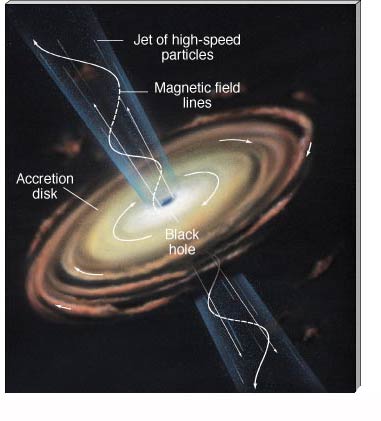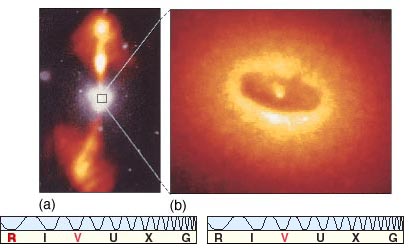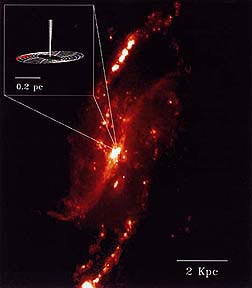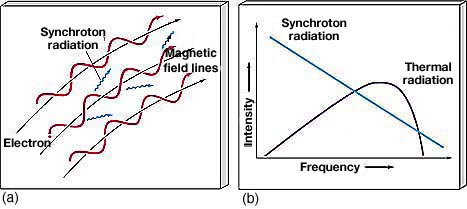The behavior of active galaxies is contrary to that expected from vast collections of stars. The lobe radio galaxies in particular, with their huge energy emission from far beyond the optical galaxy, are among the most powerful objects in the universe. Can we explain this enormous nonstellar energy output in terms of known physics? Remarkably, the answer is yes. The present consensus among astronomers is that, despite the great differences in appearance, Seyferts and radio galaxies may share a common energy-generation mechanism. The energy can be reprocessed into many different forms before it is finally emitted into intergalactic space, but the basic engine is probably the same in both cases.
As a class, active galaxies (and quasars too, as we will see) show some of or all the following properties.
The principal questions then are: How can such vast quantities of energy arise from these relatively small regions of space? Why is so much of the energy radiated at low frequencies, especially in the radio and infrared? And what is the origin of the extended radio-emitting lobes and jets? Let us first consider how the energy is produced.
To develop a feeling for the enormous emissions of active galaxies, consider for a moment an object with a luminosity of 1038 W. In and of itself, this energy output is not inconceivably large. The brightest giant ellipticals are comparably powerful. Thus, some 1012 stars—a few normal galaxies' worth of material—could equivalently power a typical active galaxy. The difficulty arises when we consider that in an active galaxy this energy production is packed into an object much less than a parsec in diameter!
It is difficult to imagine how several Milky Way Galaxies could be compressed into a space no larger than a parsec. Even if we could somehow squeeze that much mass into such a volume, it would immediately collapse to form a huge black hole, and none of the light it produced could escape. Thus, even neglecting its nonstellar spectrum, the total energy output of an active galaxy simply cannot be explained as the combined energy of many stars. We must think of something else.
The twin requirements of large energy generation and small physical size bring to mind our discussion of X- and gamma-ray sources in Chapter 22.
(Secs. 22.3, 22.7) The presence of the jet in M87 and the ejection of matter to form radio lobes in Centaurus A and Cygnus A strengthen the connection. Recall that the best current explanation for those "small-scale" phenomena involves the accretion of material onto a compact object—a neutron star or a black hole. Large amounts of energy are produced as matter spirals down onto the central object, and high-speed jets may well be a common by-product of the process (see Figure 22.6). In Chapter 23, we suggested that a similar mechanism, involving a supermassive black hole—one with a mass of around a million suns—may also be responsible for the energetic radio and infrared emission observed at the center of our own Galaxy.
(Sec. 23.7)
As illustrated in Figure 25.11, the leading model for the central engine of active galaxies is essentially a scaled-up version of the same accretion process, only now the black holes involved have masses between a few million and a billion times the mass of the Sun. As with its smaller-scale counterparts, infalling gas forms an accretion disk and spirals down toward the hole. It is heated to high temperatures by friction within the disk and emits large amounts of radiation as a result. In this case, however, the origin of the accreted gas is not a binary companion, as in stellar X-ray sources, but entire stars and clouds of interstellar gas that come too close to the hole and are torn apart by its strong gravity.

Figure 25.11 The leading theory for the energy source in active galactic nuclei (and quasars) holds that these objects are powered by material accreting onto a supermassive black hole. As matter spirals toward the hole it heats up, producing large amounts of energy. At the same time high-speed beams of gas may be ejected perpendicular to the accretion disk, forming the jets and lobes seen in many active objects. Magnetic fields generated in the disk are carried by the jets out to the radio lobes, where they play a crucial role in producing the observed radiation.
Accretion is extremely efficient at converting infalling mass (in the form of gas) into energy (in the form of electromagnetic radiation). Detailed calculations indicate that as much as 10 or 20 percent of the total mass—energy of the infalling matter can be radiated away before it crosses the hole's event horizon and is lost forever. Since the total mass—energy of a star like the Sun—the mass times the speed of light squared—is about 2 1047 joules, if follows that the 1038-W luminosity of a bright active galaxy can be accounted for by the consumption of only 1 solar mass of gas per decade by a billion—solar mass black hole.
(See Section 16.5) Less luminous active galaxies would require correspondingly less fuel—for example, a 1036-W Seyfert galaxy would devour only one star's worth of material every thousand years.
In this picture the small size of the emitting region is a direct consequence of the compact nature of the central black hole. Even a billion—solar mass hole has a radius of only 3 109 km, or 10-4 pc—about 20 A.U.—and theory suggests that the part of the accretion disk responsible for most of the emission is much less than a parsec across. Instabilities in the accretion disk can cause fluctuations in the energy released, leading to the variability observed in many objects. The broadening of the spectral lines observed in the nuclei of Seyferts (and in quasars) results from the rapid orbital motion of the gas in the hole's intense gravity.
Recent observations of galaxies in the Virgo Cluster by the Hubble Space Telescope lend strong support to this general picture. Figure 25.12 shows an image of a disk of gas and dust apparently feeding a possible black hole at the core of a giant elliptical galaxy. As expected from the theory just described, the disk is perpendicular to the huge jets emanating from the center of the active galaxy.

Figure 25.12 (a) A combined optical/radio image of the giant elliptical galaxy NGC 4261, in the Virgo Cluster, shows a white visible galaxy at center, from which red-orange (false color) radio lobes extend for about 60 kpc. (b) A close-up photograph of the galaxy's core reveals a 100-pc-diameter disk surrounding a bright hub that presumably harbors a black hole.
Hubble has also allowed astronomers to probe the fine details of the Virgo Cluster's most prominent object—the huge M87 galaxy (Figure 25.5)—and what they have found is again in excellent agreement with the idea that the energy is produced by accretion onto a large black hole. At M87's distance, Hubble's resolution of 0.05" corresponds to a distance of about 5 pc, so we are still far from seeing the (solar system—sized) central black hole itself, but the improved "circumstantial" evidence has convinced many doubters of the correctness of the theory. Figure 25.13 shows imaging and spectroscopic data that suggest the existence of a rapidly rotating disk of matter orbiting the galaxy's center, perpendicular to the jet. Measurements of the gas velocity on opposite sides of the disk indicate that the mass within a few parsecs of the center is approximately 3 109 solar masses—we assume that this is the mass of the central black hole.

Figure 25.13 Imaging and spectroscopic observations of M87 support the idea of a rapidly whirling accretion disk at its core. (a) An image of the central region of M87, similar to that shown in Figure 25.5(d), shows its bright core and jet. The scale is comparable to the scale of Figure 25.5(c). (b) A magnified view of the core suggests a spiral swarm of stars, gas, and dust. (c) Spectral-line features observed on opposite sides of the core show opposite Doppler shifts, implying that the material there is coming toward us on one side and moving away from us on the other. The strong implication is that an accretion disk spins perpendicular to the jet, and that at its center is a black hole having some 3 billion times the mass of the Sun.
Even more compelling evidence for a supermassive black hole comes from radio studies. Using the Very Long Baseline Array—a continent-wide network of 10 radio telescopes—a U.S.—Japanese team was able to achieve angular resolution hundreds of times better than that attainable with the Hubble Space Telescope. VLBA observations of NGC 4258, a spiral galaxy about 6 Mpc away, have uncovered a group of molecular clouds swirling in an organized fashion about the galaxy's core. The astronomers have detected the red- and blueshifts of water-vapor spectral lines in those faraway clouds. As depicted in Figure 25.14, the pattern revealed by the clouds is that of a slightly warped and spinning disk centered precisely on the galaxy's heart. The rotation velocities imply the presence of more than 40 million solar masses all packed within a region less than 0.2 pc across.

Figure 25.14 A network of radio telescopes has probed the core of the spiral galaxy NGC 4258, shown here in the light of mostly hydrogen emission. Within the innermost 0.2 pc (inset), observations of Doppler-shifted molecular clouds (designated by red, green, and blue dots) show that they obey Kepler's third law perfectly, and have revealed a slightly warped disk of rotating gas (shown here in artist's conception). At the center of the disk presumably lurks a huge black hole.
The model just described is now widely accepted as the correct picture of how active galaxies and quasars generate their enormous power. It provides a natural explanation of the observed facts and has the added advantage of being essentially similar to the processes thought to power smaller-scale phenomena, such as stellar X-ray sources and normal galactic nuclei. Having accounted for the source of the energy in active galaxies, let us now turn to the way in which it is eventually emitted into intergalactic space.
In general, the theoretically predicted radiation spectra for matter accreting onto a black hole do not match well with the spectra observed in active galaxies. In order to account for the details of the spectra of Seyfert galaxies, it is necessary to modify the mechanism just described by adding the assumption that the energy emitted from the accretion disk is "reprocessed"—that is, absorbed and reemitted at infrared and longer wavelengths—by gas and dust surrounding the nucleus.
A different reprocessing mechanism is responsible for the spectra of the jets and lobes seen in many active galaxies, especially radio galaxies. The jets consist of material (mainly protons and electrons) blasted out into space—and out of the visible portion of the galaxy entirely—from the inner regions of the disk. The details of how jets form remain uncertain, but there is a growing consensus among theorists that jets are a common feature of accretion flows, large and small. The jets also contain strong magnetic fields (shown in Figure 25.11), possibly generated by the swirling gas motion within the disk; the fields accompany the gas as it leaves the galaxy.
As sketched in Figure 25.15(a), whenever a charged particle (here an electron) encounters a magnetic field, it tends to spiral around the field lines. We have encountered this idea several times previously, in a variety of different contexts (see, for example, the discussion of planetary magnetospheres in Chapters 7 and 11, or solar activity in Chapter 16. As the particles whirl around, they emit electromagnetic radiation, as discussed in Chapter 3. (Sec. 3.2) The faster the particles move, or the stronger the magnetic field, the greater the amount of energy radiated. In most cases, the fastest-moving particles are the low-mass electrons, so they are responsible for most of the radiation we observe.

Figure 25.15 (a) Charged particles, especially fast electrons (red), emit synchrotron radiation (blue) while spiraling along magnetic field lines (black lines). This process is not confined to active galaxies. It occurs, on smaller scales, when charged particles interact with magnetism in Earth's Van Allen belts (see Chapter 7), when charged matter arches above sunspots on the Sun (see Chapter 16), in the vicinity of neutron stars (see Chapter 22), and at the center of our own Galaxy (see Chapter 23). (b) Variation in the intensity of thermal and synchrotron (nonthermal) radiation with frequency. Thermal radiation, described by a blackbody curve, peaks at some frequency that depends on the temperature of the source. Nonthermal synchrotron radiation, by contrast, is most intense at low frequencies. It is independent of the temperature of the emitting object. Compare this figure with Figure 25.1.
The electromagnetic radiation produced in this way—called synchrotron radiation, after the type of particle accelerator in which it was first observed—is nonthermal in nature: there is no link between the emission and the temperature of the radiating object, so the radiation is not described by a blackbody curve. Instead, its intensity decreases with increasing frequency, as shown in Figure 25.15(b). This is just what is needed to explain the overall spectrum of radiation recorded from active galaxies (compare Figure 25.15b with Figure 25.1). Observations of the radiation received from the jets and radio lobes in active galaxies are completely consistent with this process.
Eventually, the jet is slowed and stopped by the intergalactic medium, the flow becomes turbulent, and the magnetic field grows tangled. The result is a giant radio lobe, like those pictured in Figures 25.6—25.8, emitting virtually all its energy in the form of synchrotron radiation. Even though the radio emission comes from an enormously extended volume of space that dwarfs the visible galaxy, the source of the energy is still the (relatively) tiny accretion disk—a billion billion times smaller in volume than the radio lobe—lying at the galactic center. The jets serve merely as a conduit to transport energy from the nucleus, where it is generated, into the lobes, where it is finally radiated into space.
The existence of the inner lobes of Centaurus A and the blobs in M87's jet imply that jet formation may be an intermittent process. There is also evidence to suggest that much of, if not all, the activity observed in nearby active galaxies could have been sparked by recent interaction with a neighbor. Many nearby active galaxies (Centaurus A, for example) appear to have been "caught in the act" of interacting with another galaxy, suggesting that the fuel supply can sometimes be turned on by a companion. Just as tidal forces can trigger star formation in starburst galaxies (Chapter 24), they may also divert gas and stars into the galactic nucleus, triggering an outburst that may last for millions or even billions of years. (Sec. 24.4)